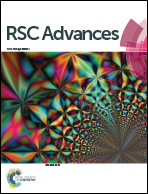Mechanism of photoluminescence enhancement and quenching in Nd2O3 nanoparticles–ferroelectric liquid crystal nanocomposites
Abstract
The mechanism of photoluminescence enhancement and quenching in np-Nd2O3:FLC nanocomposites has been explored in the current study by UV-Vis and photoluminescence (PL) spectroscopy techniques. UV-Vis absorption spectra of Nd2O3 NPs in the 200–800 nm range shows two absorptions at 248 nm and 292 nm whereas pure FLC gives a broad absorption in the 265 nm to 348 nm region. PL emission intensity of np-Nd2O3:FLC composites recorded at 248 nm excitation wavelength where Nd2O3 NPs show intense emission, increases with gradually increasing the concentration of NPs up to 8 μl. This enhancement in PL intensity without blue/red shifting the FLC's emission band was attributed to the up-conversion of doped Nd3+ ions and transfer of excitation energy to liquid crystal molecules. When excited with 248 nm, the Nd3+ ground state 4I9/2 absorption excites electrons to a higher excited state 2G5/2. The excited Nd3+ ions in 2G5/2 level relax non-radiatively to the metastable 2H11/2 state and then re-excites to an unstable 4G11/2 level. The electrons populated in 4G11/2 release energy either radiatively to different defect energy levels in the visible region or transfers this excitation energy to liquid crystal molecules which resulted into the enhancement in PL emission intensity. On the other hand, emission spectra at 303, 323, 333, 343 nm excitation wavelengths exhibit quenching of all emission bands in np-Nd2O3:FLC composites due to the stress induced structural disordering by the Nd2O3 NPs in the FLC matrix and creation of non-radiative channels in the system.


 Please wait while we load your content...
Please wait while we load your content...